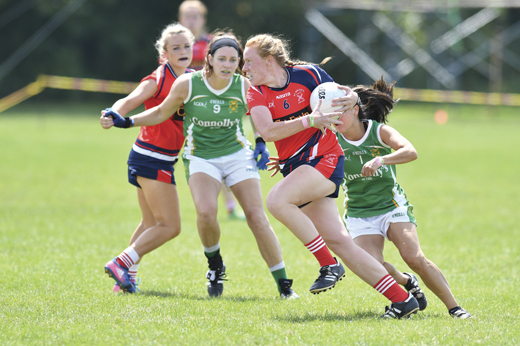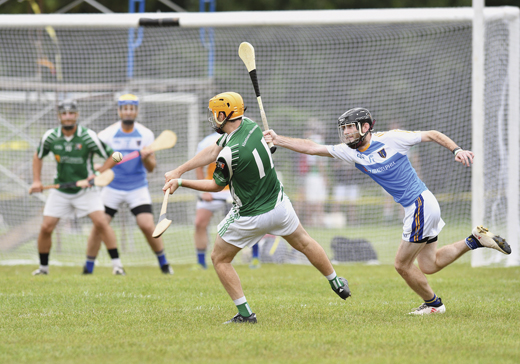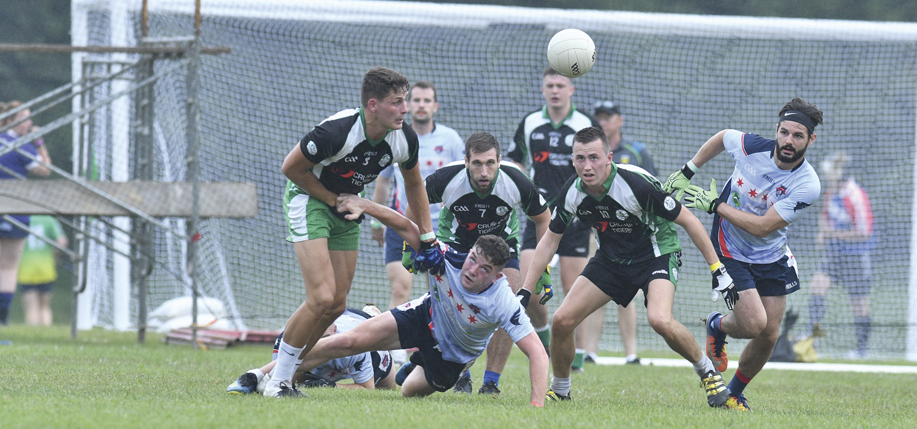The passion, competition, and camaraderie of supporters and players of Gaelic games were on display at the USGAA Finals in Philadelphia over Labor Day Weekend.
℘℘℘
September is traditionally the last month of the GAA season as the best of the best in Ireland play each other in the All-Ireland Finals. September is also the time of USGAA Finals, a competition that pits the best Hurling, Camogie, and Gaelic Football teams in North America against each other. It’s a gathering that’s been growing since the championship began 22 years ago, in 1996. Today, an estimated total of 2,000 people gather annually to participate in the three-day weekend of games, no matter how far they have to travel.
This year the games were just outside Philadelphia, Pennsylvania. In the early hours of a wet and rainy Friday morning in Malvern, P.A., “an Irish day,” there was already a massive buzz surrounding the grounds despite the weather, as teams from all over, the U.S. and Canada, coaches, organizers, heads of the some 200 GAA clubs and their supporters and families started to arrive. There were lots of greetings; handshakes and catch-up talk of years gone by. Stories circulated amongst the GAA faithful, of rising stars and veteran players, of hard-to-beat teams, and players who showed great promise.
Over the next three days, 100 teams – hurling, camogie (the female version of hurling), and Gaelic football – would be split into different skill levels – from Senior to Junior B; then divided into four divisions; to play in 19 different competitions.
As I walked around the manicured pitches and tents full of equipment, food, and drink, the majority of the voices were distinctly American, cheery, and enthusiastically looking forward to the days ahead. For many of those gathered it had become a yearly tradition, a chance to connect with others who shared their love of Gaelic games. There were large contingents from Milwaukee, Charlotte, Chicago, and several teams from San Francisco.

DAY ONE:
I followed the camogie action on the first day of the tournament. Like hurling, camogie demands a tremendous level of skill, fitness, ball control, and heart, and this soon became evident as the Seattle Gaels and the New York Annie Moores took the field. The difference between the two teams was supposed to be a major factor, given that the Gaels club was established in the 1970s and had won a USGAA title in 2016, and the Annie Moores were a relatively new team, but the level of play was superb on both sides.
While the Gaels did take the lead at half time, the Annie Moores showed the old New York grit and determination to come back and made it a competitive game by scoring two great team play goals. However, the Seattle Gaels went out on top despite the New York determination.
Camogie doesn’t always get the recognition and respect that it deserves, and many of the women I talked to over the weekend were adamant about wanting to see the community and their sport expand. “We’re pro-camogie, we’re all about our sport and we want our sport to grow,” Heather Morris of Seattle Gaels emphasized.
Another terrific camogie match-up that caused much excitement was a junior game between the Philadelphia Na Tóraidhe, and the Milwaukee Hurling Club, one of the largest GAA clubs in the United States. Founded in 1996 with just 34 players the club now boasts over 300. Unlike most other clubs, the MHC fields co-ed teams, and is primarily made up of players who are American, and have never seen or played the game before.
The Philadelphia side, led by Katrina Terry performed well for their first USGAA National Championship and went on to win their first game. Despite the loss the MHC team manager Cory Johnson explained that, “In the Milwaukee Hurling Club we’re all about family first, game second, so I think what happens when we come to the Nationals and they [new players] see the veterans who are shaking hands and hanging out with St. Louis, or there’s hugs with Minnesota, or seeing all the babies, I think they get that pretty quickly, and then they go home and become addicted.”
This feeling of acceptance, growth, and focus on family was a spontaneous theme that weekend. After a long day of games and torrential downpour, all the clubs went out to dinner or to bars to relax and enjoy each other’s company before they became rivals the next day.

DAY TWO:
I watched more Gaelic football and hurling and this time I spoke with Irish-born players who had a lot to say about their American or Canadian teammates. The first game on the day was not the greatest as the J.P. Ryans handily beat the Washington D.C. Gaels but the manager for the victorious the Ryans of Vancouver saluted his American opponents. “I’d have to say, they were very, very committed, and it’s the same thing you get when you come to North American Championships, the commitment is unbelievable. I have to say the American born-players, the effort they put in, their fitness, and physicality always seems to be better than ours [Irish players in Canada].”
For the second game, I stuck with the D.C. Gaels as they were playing against a Philadelphia side, the Notre Dames, a squad of all Americans who won out in the end. Despite going 0-2 on the day in hurling and football, there was a unique perspective from Sophie Friedl, a dual player (one who plays Gaelic football and hurling camogie), as she started playing Gaelic Games in college, a major entry point for Americans into Gaelic Games. “I have been playing co-ed hurling and camogie since I was in college with the Montana Grizzlies, we started a team out there and we were pretty successful, I went to play in Ireland for a year, and moved to D.C. and knew there had to be a team and I’ve been playing football with them for the first time and we’re growing with both codes.” Throughout the weekend, Sophie and I saw so many friends we played against in the NCGAA tournaments with, and we reminisced about old times, and we all agreed wherever we play there is always someone you know.
There was an exciting local hurling semi-final between Allentown Hibernians and Philadelphia Na Tóraidhe right after the D.C. Gaels doubleheader where tempers flared and hurls flew. Both teams are known for their fiery passion and find pride in their traditions of American recruitment. The Pennsylvanians fought hard against each other but Allentown beat the hosts in the end to claim bragging rights until the season starts up again despite the close loss, one of the main men from Na Tóraidhe, Anthony Picozzi recognized their determination by making a congratulatory speech to the opposition, another proud tradition of the GAA. The sun finally started to come out and it was soon time to check out two of the last games of the day, a senior semi-final between the J.P. Ryans and the Austin Celtic Cowboys, and the other, senior semi-final between Tipperary Boston and San Francisco Na Fianna, and they were two of the best matches of the weekend. The GAA and clubs throughout the United States and Canada is home away from home for a lot of Irish immigrants, whether they’re looking for a change from living in Ireland or need to find work the GAA is always an opportunity to make business connections, make new friends or reunite with old ones, just like Paul Nolan of the Vancouver J.P. Ryans who came to Canada looking for a new change in work: “I just took a couple years out to work somewhere different so I’m here now and seen the club before I came over and became involved with them.” Paul, actually reunited with a old college roommate at the Finals he went to school with, a Liberty Gaels coach. Talk about a home away from home.
Two great hurling matches later, the games were over for another day, but everyone was bursting to watch the championships the next day.

DAY THREE:
The final day of the USGAA Finals was a great one full of drama, heartbreak, joy, and an emphasis on homegrown players. The first game I watched was the Junior Camogie final between Coastal Virginia GAA and Seattle Gaels. The Virginians won out on the day, making the first of two championships that the club as a whole went on to win. If you listen to our podcast, The Story, you’ll know all about the emphasis on family Coastal Virginia has, as they are currently in a process of adding more and more children to their ranks to eventually grow the game. Captain Heather Warren said it this way: “We’re all friends, we all hang out together, you know. I mean we are a family, we support our guys, they support us, we have a lot of couples. We’re just going to make our own youth team, we’re all American and we’re here to have fun.”
Another All-American side, the Patriots from Chicago, were facing up against tough competition: the Austin Celtic Cowboys, a side that had a strong Irish contingent in the Intermediate Football final. The Patriots took it to the Cowboys as they fought hard to tie the game before the half time whistle. Their extra efforts almost saw them win the cup as they only lost by two points to the more experienced Celtic Cowboys. The representative from the USGAA presenting the trophy gave words of encouragement to the Patriots: “ I’ve been watching ye for the last ten years and you’re a great credit. You’ve started off at Junior, you’re doing the right thing coming up the ranks, and you’re not too far from Senior.”
One of the best matches at the weekend was the Senior Ladies Gaelic football Final between the Charlotte James Connolly’s and the Chicago Saint Brigids. The two sides had great support from both of their clubs, but the effort put in by the travelling support of the Charlotte James Connolly’s was impressive: they not only had 50 or 60 supporters show up, they also had a full live stream with live commentary and a whole tent just to house the equipment meant to broadcast between a drone and the regular camera. However, the support didn’t help the Charlotte side over the line and, despite their valiant efforts the Saint Brigids of Chicago went on to win by a point in a very close and exciting game that ended up with 11 goals total in the match.
One of the best ways to describe the range of emotions the supporters like Charlotte James Connolly’s felt that weekend was in the words of David Wogan of Play Hurling, who promotes Gaelic Games through social media. He described the USGAA Finals by saying “We all share a passion for hurling, camogie, and Gaelic football, and that’s a beautiful thing.”

While there is always some beauty, there is also some pain as not every team could win a championship. One of the harder stories, for some anyway, (joyful for others) was the Senior Camogie final, the very last game of the weekend, between the Liberty Gaels who wanted to return home with the trophy for, the fourth year in a row, and the San Francisco Cú Chulainns, who weren’t afraid to foil the Gaels’ plan. While the Liberty Gaels were the favorites, and it looked like they were about to bring home the trophy with the amount of goals they scored in the first half, it didn’t shake the Cú Chulainns at all. In the second half they came out roaring and brought the game closer and closer until the very last puck when the Liberty Gaels gave away a free while the game was tied up. Into the limelight stepped goalkeeper Rita Burke, who took her free, and slayed her Cú – just as Setanta did when he became Cú Chulainn – winning the championship.
The weekend of competition and the year of hard Finals were over, but that didn’t bring down the place at all. The buzz continued in the beer tent, where people were dancing, throwing hay bales around for the fun of it, and having friendly drinks between those who were sworn enemies merely hours ago. On the outside looking in, people might think that the games and the community are niche or the sport looks too rough and intimidating to get involved with, but the GAA in the USA is one of, if not the most, friendly and welcoming sports organizations around today. Naturally sports and tournaments like these are often about winning, and yet I saw these people celebrating together the spirit and focus of the GAA which are community, friendship, and passion for heritage. These people won off the pitch, no matter if their team won or lost while on it. ♦ Dave Lewis


Great stuff, thanks for the wonderful article. The finals each year are such a great experience, win or lose.
On June 1, i958, as a teenager and new arrival in NYC, I went to the Polo Grounds to see the Leage Champions of Ireland, Tipperary in hurling, and Meath in Gaelic football LOSE to New York teams in both matches. The visitors were at a disadvantage because they weren’t usud to New York heat and humidity. About 7 years later, the U.S. passed new immigration laws, which made it exceedingly for young immigrants to obtain permanent visas, and that severely hurt the G.A.A. iat this side of the bond.
In the late ’50 and early ’60s one would often see an Irish immigrant or two waering a U.S. Army uniform at Gaelic Park. I personally knew Jimmy Dolan who was stationed at Fort Dix and often played for his native Offaly. I once read that star footballed Mickey O’Sullivan, a native of west Limerick, served with the U.S. Army in Korea. Is that right?.